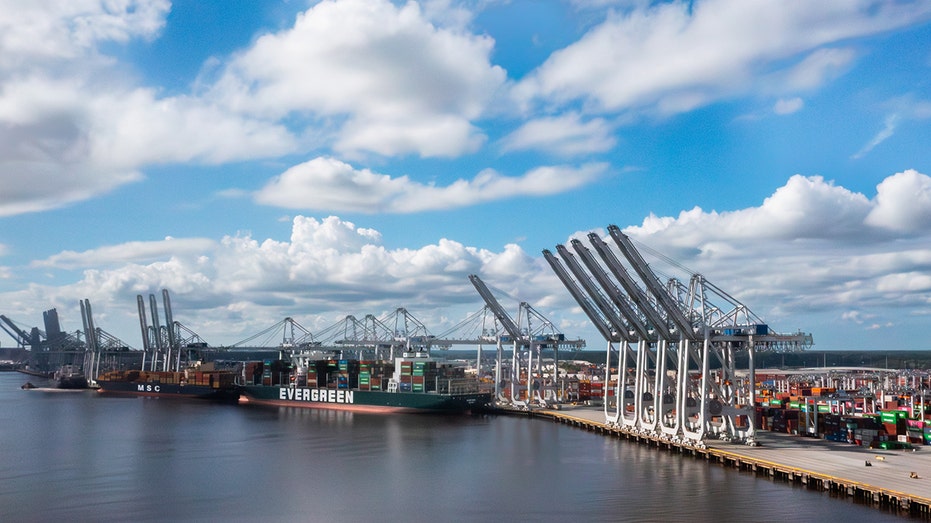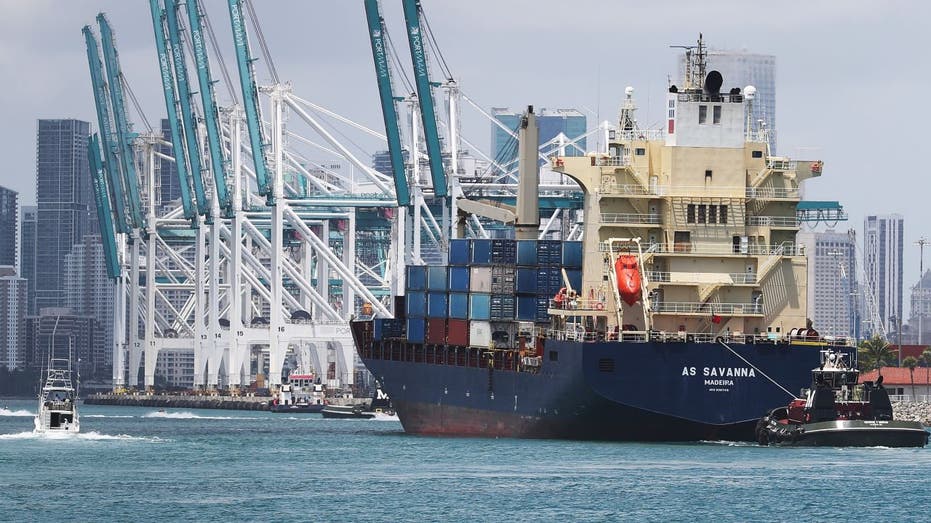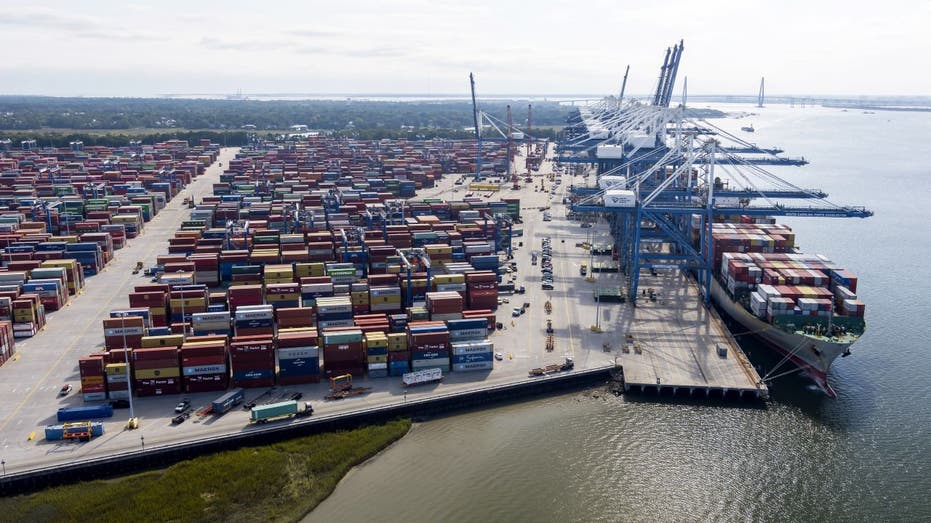Port of Los Angeles executive director Gene Seroka discusses the key issues of the impending ports strike on Cavuto: Coast to Coast.
A potential strike by unionized dockworkers could begin Tuesday at East and Gulf Coast ports, raising questions about whether West Coast ports are a viable alternative destination for unloading cargoes.
The International Longshoremen’s Association (ILA), which represents 45,000 dockworkers, and the U.S. Maritime Alliance (USMX) that represents port employers are at an impasse in negotiations over the union’s demands for compensation and protection from automation. The union’s current six-year contract expires Monday night, raising the prospect of the ILA’s first strike since 1977.
With time dwindling for the two sides to reach an agreement that avoids a work stoppage, the possibility of a strike by dockworkers at 36 East and Gulf Coast seaports could put about half of the country’s import volume at a standstill — raising questions about whether shipments can be diverted to the West Coast.
Douglas Kent, EVP of corporate and strategic alliances at the Association for Supply Chain Management (ASCM), told FOX Business in an interview that while it makes sense to consider alternative destinations to mitigate risk, “The West Coast ports can’t handle an additional 50% of goods coming through there.”
PORT STRIKE WILL BRING ANOTHER HIT TO FARMERS, SAYS FORMER TRUMP OFFICIAL

Dockworkers with the ILA could go on strike if a last minute deal isn’t reached by midnight on Sept. 30. (Sam Wolfe/Bloomberg via Getty Images / Getty Images)
“We have severe passage constraints through the Panama Canal because of the drought, so even that isn’t always the answer,” Kent said. “That’s an additional week-plus shipment, assuming that there’s no backlog on the other side. So the cost associated with the re-routing of a shipment is also not to be underestimated.”
Kent explained that because East and Gulf Coast ports handle more shipments to and from Europe, while West Coast ports handle most of the trade with Asia, there are capacity and cost considerations that factor into decisions about re-routing shipments.
LOOMING PORT STRIKE BY THE NUMBERS: NEW YORK, SAVANNAH, BALTIMORE EXPECTED TO SEE DISRUPTIONS

The Port of Savannah is among the ports that could experience a stoppage. (Elijah Nouvelage/Bloomberg via Getty Images / Getty Images)
“I don’t think we’re going to see a lot of re-routing. I do think that the ports on the West Coast are preparing for some increase in volume associated with that. But their ability to absorb nearly 50% of the import volume is not even a remote possibility,” Kent said.
“What they don’t want to do is also inadvertently cause the strain on their own operation,” he explained. “So I think you’ve got to also play that factor in mind in terms of any potential re-routing. They’ll accept an acceptable volume that doesn’t overstress their existing capabilities and upset their existing customer base because their customers that have been loyal to them and routing through them, they don’t want to disrupt that.”

The Port of Baltimore is the largest hub for car shipments. (Jim Watson/AFP via Getty Images / Getty Images)
Port of Los Angeles Executive Director Gene Seroka said in an interview on FOX Business Network’s “Cavuto: Coast to Coast” that “very few people win when it comes to situations like this. These workers have to get paid. The companies must continue to reinvest and bring cargo in, which creates jobs from Maine to Texas for this great union and their employers association.”
Host Neil Cavuto asked Seroka about the timing of the potential port strike in advance of the holiday season on shoppers’ ability to access in-demand products.
“The timing couldn’t be any worse,” Seroka said. “We’re on the doorstep of the retail holiday season. And set aside the big box retailers for just a second, who had the wherewithal to advance cargo and bring it in through other ports and get their inventory set up. It’s that small- to medium-sized business that I’m concerned with. Typically, they run these last 12 weeks before the holiday to make payroll and keep their businesses viable, that’s what’s at risk right now.”
THE TAFT-HARTLEY ACT: WHY BIDEN COULD USE THIS LABOR LAW TO PREEMPT A PORT STRIKE

The Port of Miami is among the seaports that could see a work stoppage. (Joe Raedle/Getty Images / Getty Images)
West Coast ports like Los Angeles, Long Beach, Oakland and Seattle-Tacoma are the major seaports that could be destinations for re-routed shipments. Port operators aren’t expecting a significant impact.
“We anticipate little to no impact on Port of Oakland cargo operations should there be an East Coast dockworker strike,” a spokesperson for the Port of Oakland told FOX Business.
Port of Long Beach CEO Mario Cordero told FOX Business in a statement that the port is “fluidly processing record volumes of cargo” and that the port is ready to respond if needed should the dockworkers strike proceed at East and Gulf Coast ports.
“We hope for a timely and mutually beneficial resolution for the contract covering the East and Gulf Coasts. However, should the need arise, we will depend on the close relationships we have developed with our partners in industry and labor to work to keep the supply chain moving, and the U.S. economy functioning,” Cordero said. “We are prepared to activate our Business Recovery Task Force for the duration in the event of any disruption of cargo movement in this region as a result of work stoppages elsewhere.”
GET FOX BUSINESS ON THE GO BY CLICKING HERE
The potential port strike could cost the U.S. economy upwards of $5 billion per day, as a J.P. Morgan analysis estimated a range between $3.8 billion and $4.5 billion a day. Some of that would be recovered after the end of the strike and ports recovered to normal operations over time.
The 36 East and Gulf Coast ports that could be impacted by the strike collectively handle half of the seaborne imports to the U.S., with significant amounts of agriculture products and vehicle imports, as well as machinery, fabricated steel and precision instrument imports in the balance. Those ports are also significant hubs for exports of U.S. agricultural and pharmaceutical products.
FOX Business’ Aislinn Murphy contributed to this report.



